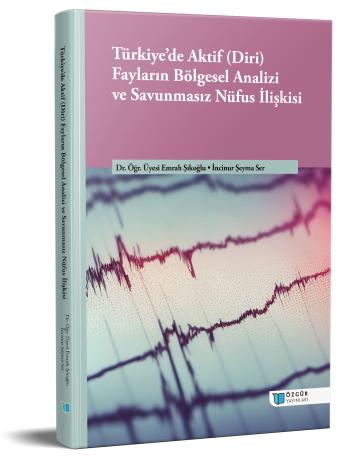
Türkiye’de Aktif (Diri) Fayların Bölgesel Analizi ve Savunmasız Nüfus İlişkisi
İndir
Özet
Doğal afetler, insanlık tarihinde karşılaşılan en büyük trajedilerden biri olarak kabul edilmektedir ve bu felaketler arasında depremler, toplumlar üzerinde özellikle derin ve kalıcı etkiler bırakabilen doğa olaylarıdır. Bu çalışma, Türkiye’deki aktif fay hatlarının nüfus yapısı ile ilişkisini ayrıntılı bir şekilde incelemektedir. Öncelikle, farklı bölgelerde yer alan aktif fay hatlarının dağılımı ve bu bölgelerdeki genel nüfus yoğunluğu arasındaki ilişki araştırılmıştır. Ardından, aktif fay hatlarından geçen illerde, özellikle 0-14 yaş ve 65 yaş üstü gibi daha savunmasız nüfus gruplarının oransal dağılımı incelenmiştir. Bu yaş grupları, fiziksel sınırlılıklar nedeniyle deprem sırasında kendilerini koruma ve kurtarma yetenekleri kısıtlı oldukları için özel önem taşımaktadır.
Türkiye’de toplam 922 ilçe ve 81 il bulunmaktadır. Aktif fay hatları, Türkiye’nin idari sınırları içinde bulunan 536 ilçe ve 68 ilden geçmektedir. Ülke genelindeki 85.279.553 nüfusun %75.80’i, yani kişi, bu aktif fay hattı bölgelerinde yaşamaktadır. Türkiye'de aktif fay hatları üzerinde yaşayan ve Türkiye nüfusunun %75.80’ini oluşturan 64.643.681 kişinin %17.67’si savunmasız nüfusa karşılık gelmektedir. Bölgesel olarak Ege, Doğu Anadolu ve İç Anadolu bölgeleri, en fazla diri (aktif) fay hattı geçen il sayısına sahiptir. Risk azaltıcı önlemler kapsamında, diri fay hattı ve nüfus yoğunluğu dikkate alınarak yapılan analizler, en riskli bölgelerin Ege, Marmara ve İç Anadolu olduğunu göstermektedir. İzmir, Manisa ve Aydın (Ege); Bursa, Kocaeli ve Balıkesir (Marmara); Kayseri, Konya ve Eskişehir (İç Anadolu), diri fay hatları üzerinde yer alan ve yüksek nüfusa sahip riskli iller arasındadır. Analiz sonuçları, İç Anadolu, Ege ve Akdeniz bölgelerinde özellikle 65 yaş üstü savunmasız nüfusun yoğun olduğu alanları en riskli bölgeler olarak belirlemiştir.
Türkiye’deki aktif fay hatları üzerinde yaşayan nüfusun %17.67’sini savunmasız nüfus gruplarının oluşturması, çeşitli önlemlerin alınmasını zorunlu kılmaktadır. Bu önlemler arasında depreme dayanıklı yapıların inşası, deprem eğitimi ve bilinçlendirme faaliyetlerinin artırılması, deprem sonrası müdahale ve iyileştirme planlarının hazırlanması ve uygulanması, diri fay hatlarının ve deprem risklerinin güncellenmesi, özellikle 65 yaş ve üzeri nüfus için ekonomik ve sağlık durumları, afet tecrübeleri, aile ve topluluk bağları, sosyal sermaye, toplumsal cinsiyet gibi faktörlerin detaylı analizi bulunmaktadır. Savunmasız nüfus, temel ihtiyaçlara erişimde zorluk yaşayan veya yaşama ihtimali yüksek olan gruptur. Bu nedenle, savunmasız nüfus oranı yüksek olan bölgelerde sağlık, eğitim, istihdam ve sosyal güvenlik gibi alanlarda yeterli kamu hizmetlerinin sağlanması gerekmektedir.

